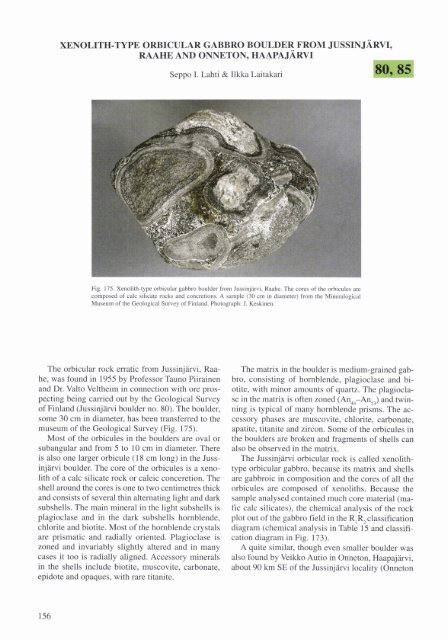xenolith-type orbicular gabbro boulder from jussinjärvi ... - Arkisto.gsf.fi
xenolith-type orbicular gabbro boulder from jussinjärvi ... - Arkisto.gsf.fi
xenolith-type orbicular gabbro boulder from jussinjärvi ... - Arkisto.gsf.fi
Create successful ePaper yourself
Turn your PDF publications into a flip-book with our unique Google optimized e-Paper software.
XENOLITH-TYPE ORBICULAR GABBRO BOULDER FROM JUSSINJÄRVI,<br />
RAAHE AND ONNETON, HAAPAJARVI<br />
Seppo 1. Lahti & Ilkka Laitakari<br />
<strong>fi</strong>g. 175. Xenolith-<strong>type</strong> <strong>orbicular</strong> gaooro wuiuer rrom ~usr>injärvi, Raahe. The cores of the orbicules are<br />
composed of calc silicate rocks and concretions. A sample (30 cm in diarneter) <strong>from</strong> the Mineralogical<br />
Museum of the Geological Suwey of Finland. Photograph: J. Keskinen.<br />
The <strong>orbicular</strong> rock erratic <strong>from</strong> Jussinjärvi, Raahe,<br />
was found in 1955 by Professor Tauno Piirainen<br />
and Dr. Valto Veltheim in connection with ore prospecting<br />
being carried out by the Geological Survey<br />
of Finland (Jussinjärvi <strong>boulder</strong> no. 80). The <strong>boulder</strong>,<br />
some 30 cm in diarneter, has been transfened to the<br />
museum of the Geological Survey (Fig. 175).<br />
Most of the orbicules in the <strong>boulder</strong>s are oval or<br />
subangular and <strong>from</strong> 5 to 10 cm in diameter. There<br />
is also one larger orbicule (18 cm long) in the Jussinjärvi<br />
<strong>boulder</strong>. The coxe of the orbicules is a <strong>xenolith</strong><br />
of a calc silicate rock or caleic conceretion. The<br />
shell around the cores is one to two centimetres thick<br />
and consists of several thin alternating light and dark<br />
subshells. The main mineral in the light subshells is<br />
plagioclase and in the dark subshells hornblende,<br />
chlorite and biotite. Most of the hornblende crystals<br />
are prismatic and radially oriented. Plagioclase is<br />
zoned and invariably slightly altered and in many<br />
cases it too is radially aligned. Accessory rninerals<br />
in the shells include biotite, muscovite, carbonate,<br />
epidote and opaques, with rare titanite.<br />
The matrix in the <strong>boulder</strong> is medium-grained <strong>gabbro</strong>,<br />
consisting of hornblende, plagioclase and biotite,<br />
with minor amounts of quartz. The plagioclase<br />
in the matrix is often zoned (Ana-An5,) and twinning<br />
is typical of many hornblende prisms. The accessory<br />
phases are muscovite, chlorite, carbonate,<br />
apatite, titanite and zircon. Some of the orbicules in<br />
the <strong>boulder</strong>s are broken and fragments of shells can<br />
also be observed in the matrix.<br />
The Jussinjärvi <strong>orbicular</strong> rock is called <strong>xenolith</strong><strong>type</strong><br />
<strong>orbicular</strong> <strong>gabbro</strong>, because its matrix and shells<br />
are <strong>gabbro</strong>ic in composition and the cores of all the<br />
orbicules are composed of <strong>xenolith</strong>s. Because the<br />
sample analysed contained much core materia1 (ma<strong>fi</strong>c<br />
calc silicates), the chemical analysis of the rock<br />
plot out of the <strong>gabbro</strong> <strong>fi</strong>eld in the R,R, classi<strong>fi</strong>cation<br />
diagram (chemical analysis in Table 15 and classi<strong>fi</strong>cation<br />
diagram in Fig. 173).<br />
A quite similar, though even smaller <strong>boulder</strong> was<br />
also found by Veikko Autio in Onneton, Haapajärvi,<br />
about 90 km SE of the Jussinjärvi locality (Onneton
oulder no. 85). This <strong>boulder</strong> is roundish, only about<br />
15 cm in diameter, and consists of closely spaced<br />
multishelled orbicules in a homogeneous <strong>gabbro</strong>ic<br />
matrix (Fig. 176). The cores of the orbicules are also<br />
composed of dark-green rounded <strong>xenolith</strong>s of schist,<br />
most likely fragments of calc silicate rocks.<br />
Because the general appearance of the rocks - the<br />
core material, the shells and matrix - closely resernble<br />
each other in both the Jussinjämi and Onneton<br />
<strong>orbicular</strong> rocks, the authors believe that both erratics<br />
may be derived <strong>from</strong> a common, presently unknown<br />
source, although the distance between the localities<br />
is considerable (nearly a hundred kilomehres).<br />
ne roun&sh fom of the Onneton <strong>boulder</strong>, furthemore,<br />
indicates that it was trmsported a long dstance<br />
by the ice.<br />
Fig. 176. Weathered swface of a <strong>xenolith</strong>-<strong>type</strong> <strong>orbicular</strong> rock h m<br />
Onneton, Haapaj-Wi. The cores of the orbicules are calc-silicate rocks.<br />
A sample (about 20 cm wide) belonging to V. Autio. Photomh: J. Keskinen.<br />
ORBICULAR GABBRO BOULDER FROM KANGASPAANJARVI, REIS JARVI<br />
Seppo 1. Lahti, Ilkka Laitakari and Paula Raivio<br />
Fig. 177. Weathered swface of <strong>orbicular</strong> <strong>gabbro</strong> <strong>boulder</strong> <strong>from</strong> Kangaspahjrvi, Reisjárvi. The orbicules<br />
are medium-sized (0 5-8 cm), single-shelled and often deformed. A sample <strong>from</strong> the Mineralogical Museum<br />
of the Geological Survey of Finland. Photograph: J. Keskinen.<br />
Geologist Eero Pehkonen discovered this orbicu- cal Survey of Finland. The chemical analysis indilar<br />
rock in 1958 west of lake Kangaspaanjärvi in cate that the rock is syenodiorite in composition (Ta-<br />
Lehtoranta, near Reisjärvi. The <strong>boulder</strong> that is ble 15, Fig. 173).<br />
rounded and about 120 x 80 x 70 cm in size was The KangaspWjämi <strong>orbicular</strong> rock consists of<br />
found during geological <strong>fi</strong>eldwork of the Geologi- very closely spaced orbicules, 4-6 cm in diarneter,
















